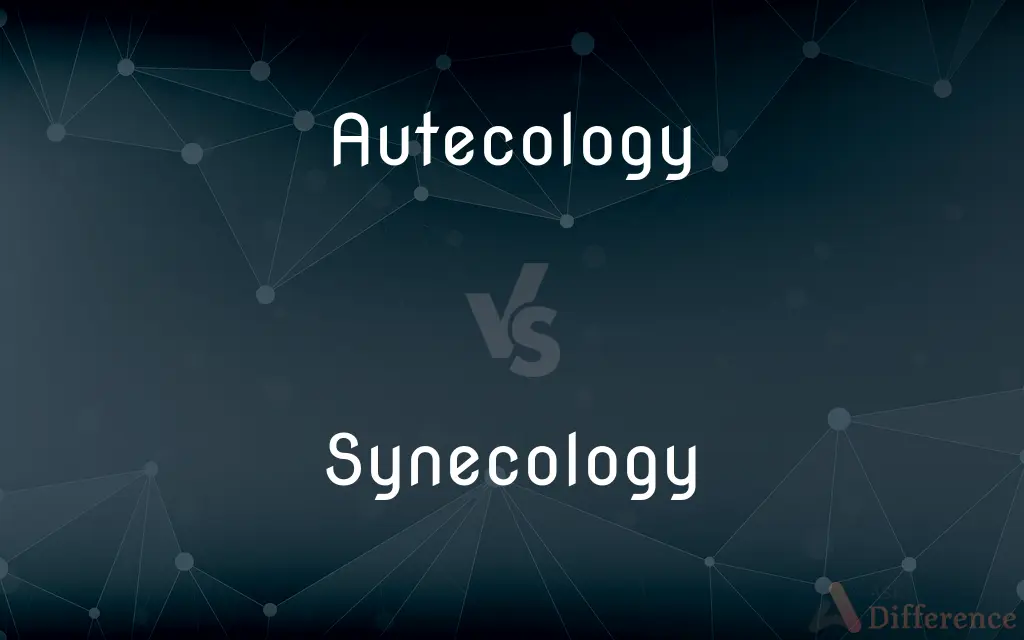Autecology vs. Synecology — What's the Difference?
By Fiza Rafique & Maham Liaqat — Updated on March 14, 2024
Autecology studies individual species and their interactions with environment, focusing on singular organism dynamics, while synecology examines relationships and interactions within communities of multiple species, emphasizing ecosystem-level processes.

Difference Between Autecology and Synecology
Table of Contents
ADVERTISEMENT
Key Differences
Autecology zeroes in on how individual species adapt to their environments, exploring aspects like habitat preferences, resource utilization, and responses to environmental changes. Synecology, on the other hand, delves into the complex web of interactions among different species within a community, including competition, predation, and symbiosis, and how these interactions shape the ecosystem.
While autecology might focus on the life cycle, behavior, and ecological niche of a single species, synecology takes a broader approach, studying how species coexist, compete, and cooperate within the same habitat, thereby providing insights into community structure, biodiversity, and ecosystem function.
In autecology, researchers might conduct detailed studies on a specific plant or animal species to understand its unique adaptations, population dynamics, and role in the ecosystem. In contrast, synecological studies involve analyzing how various species interact with each other and the environment, often employing models to understand community dynamics and ecological equilibrium.
Autecology's species-specific focus allows for in-depth understanding of particular organisms, which can inform conservation strategies and habitat management. Synecology's community-wide perspective is crucial for understanding ecological balance, resilience, and the impact of human activities on ecosystems.
Both autecology and synecology are essential for a comprehensive understanding of ecological systems, with autecology providing the foundational knowledge of species-level interactions and synecology offering insights into the complexity of life and the interconnectedness of ecosystems.
ADVERTISEMENT
Comparison Chart
Focus
Individual species and their interaction with the environment.
Interactions and relationships within communities of species.
Scope
Narrow, concentrating on singular organism dynamics.
Broad, emphasizing ecosystem-level processes.
Key Concepts
Habitat preference, ecological niche, species-specific adaptations.
Community structure, biodiversity, ecosystem function.
Research Approach
Detailed studies on specific species.
Analysis of species interactions and community dynamics.
Application
Informs conservation strategies and habitat management.
Essential for understanding ecological balance and resilience.
Typical Methods
Observational and experimental studies on single species.
Modeling and analysis of community interactions.
Contribution to Ecology
Provides foundational knowledge of species-level interactions.
Offers insights into the complexity and interconnectedness of ecosystems.
Compare with Definitions
Autecology
It explores individual species' adaptations and ecological niches.
The autecology of cacti examines their adaptations to arid conditions.
Synecology
Synecology is crucial for understanding biodiversity and ecosystem health.
Synecology helps in assessing the impact of invasive species on native communities.
Autecology
Autecological research can inform species-specific conservation efforts.
Autecological studies on sea turtles help in developing targeted conservation strategies.
Synecology
It focuses on the relationships among species and their collective impact on the ecosystem.
Synecological research might explore how different plant species compete for sunlight in a rainforest.
Autecology
The field considers factors affecting individual species' survival and reproduction.
Autecology looks at how temperature changes impact coral species.
Synecology
Synecology examines the interactions within ecological communities.
Synecology studies how predator-prey dynamics shape forest ecosystems.
Autecology
Autecology focuses on how a single species interacts with its environment.
Studying the autecology of the polar bear involves understanding its hunting behaviors and ice habitat preferences.
Synecology
Synecology provides insights into ecological balance and resilience.
Synecology research can reveal how ecosystems recover from disturbances like wildfires.
Autecology
Autecology is critical for understanding the basics of organism-environment interactions.
The autecology of bees includes their role in pollination and responses to environmental changes.
Synecology
The field analyzes community structure and function.
Synecological studies in wetlands investigate how diverse plant and animal communities maintain water quality.
Autecology
Autecology is an approach in ecology that seeks to explain the distribution and abundance of species by studying interactions of individual organisms with their environments. An autecological approach differs from both community ecology (synecology) and population ecology by greater recognition of the species-specific adaptations of individual animals, plants or other organisms, and of environmental over density-dependent influences on species distributions.
Synecology
The study of the ecological interrelationships among communities of organisms.
Autecology
The branch of ecology that deals with the biological relationship between an individual organism or an individual species and its environment.
Synecology
(ecology) One of two broad subdivisions of ecology (the other being autecology), meaning the study of groups of organisms associated as a unit (essentially a biological community).
Autecology
One of two broad subdivisions of ecology, which studies the individual organism or species.
Common Curiosities
Can autecology inform conservation efforts?
Yes, autecological research provides essential information for developing targeted conservation strategies for specific species.
What does synecology involve?
Synecology involves the study of species interactions within communities and the resulting impact on ecosystem structures and processes.
How do autecology and synecology differ in their approach?
Autecology focuses on singular species and their specific environmental interactions, while synecology examines the complex relationships among multiple species within a community.
Why is synecology important for understanding ecosystems?
Synecology is crucial for understanding the interconnectedness and dynamics of ecosystems, which is vital for managing biodiversity and ecological health.
How do researchers study autecology?
Researchers study autecology through detailed observational and experimental studies on the behavior, reproduction, and survival of individual species.
How does synecology contribute to ecosystem management?
Synecology provides insights into community dynamics and ecosystem functions, informing management practices that promote ecological balance and resilience.
How can synecological studies aid in addressing invasive species issues?
Synecological studies can help in understanding the impact of invasive species on community interactions and ecosystem balance, guiding effective management and control measures.
What is autecology?
Autecology is the study of individual species in relation to their environment, focusing on their unique adaptations, behavior, and ecological roles.
Can autecology and synecology overlap in their studies?
Yes, while autecology and synecology have distinct focuses, they can overlap when studying how individual species' roles and interactions contribute to community dynamics and ecosystem functions.
What impact do human activities have on autecological and synecological studies?
Human activities can significantly impact the subjects of autecological and synecological studies by altering habitats, introducing invasive species, and changing climate conditions, affecting species behavior and community interactions.
Do autecology and synecology contribute to climate change research?
Yes, both fields contribute to climate change research by examining how individual species adapt to changing conditions and how these changes affect community dynamics and ecosystem services.
What methods are used in synecological research?
Synecological research often employs modeling and analysis of community interactions to understand the structure and function of ecosystems.
What role does autecology play in understanding ecological niches?
Autecology is fundamental in understanding ecological niches, as it delves into the specific conditions and roles of species within their environments.
How do autecology and synecology inform biodiversity conservation?
Autecology provides detailed information on species' needs and vulnerabilities, while synecology offers a broader perspective on community interactions and ecosystem functions, both essential for informed biodiversity conservation.
Share Your Discovery

Previous Comparison
Liter vs. Gallon
Next Comparison
Android vs. iOSAuthor Spotlight
Written by
Fiza RafiqueFiza Rafique is a skilled content writer at AskDifference.com, where she meticulously refines and enhances written pieces. Drawing from her vast editorial expertise, Fiza ensures clarity, accuracy, and precision in every article. Passionate about language, she continually seeks to elevate the quality of content for readers worldwide.
Co-written by
Maham Liaqat













































